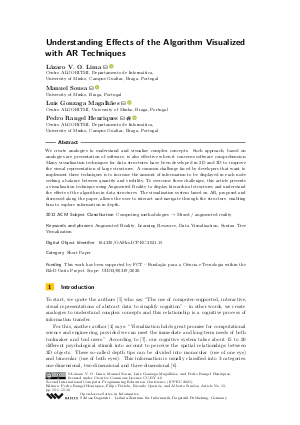Understanding Effects of the Algorithm Visualized with AR Techniques (Short Paper)
Authors
Lázaro V. O. Lima  ,
Manuel Sousa
,
Manuel Sousa  ,
Luis Gonzaga Magalhães
,
Luis Gonzaga Magalhães  ,
Pedro Rangel Henriques
,
Pedro Rangel Henriques 
-
Part of:
Volume:
Second International Computer Programming Education Conference (ICPEC 2021)
Part of: Series: Open Access Series in Informatics (OASIcs)
Part of: Conference: International Computer Programming Education Conference (ICPEC) - License:
 Creative Commons Attribution 4.0 International license
Creative Commons Attribution 4.0 International license
- Publication Date: 2021-07-01
File

PDF
OASIcs.ICPEC.2021.15.pdf
- Filesize: 1.9 MB
- 10 pages
Document Identifiers
Subject Classification
ACM Subject Classification
- Computing methodologies → Mixed / augmented reality
Keywords
- Augmented Reality
- Learning Resource
- Data Visualization
- Syntax Tree Visualization
Metrics
- Access Statistics
-
Total Accesses (updated on a weekly basis)
0Document
0Metadata
Abstract
We create analogies to understand and visualize complex concepts. Such approach, based on analogies are presentation of software, is also effective when it concerns software comprehension. Many visualization techniques for data structures have been developed in 2D and 3D to improve the visual representation of large structures. A common challenge faced by developers that want to implement these techniques is to increase the amount of information to be displayed in each node seeking a balance between quantity and visibility. To overcome these challenges, this article presents a visualization technique using Augmented Reality to display hierarchical structures and understand the effects of the algorithm in data structures. The visualization system based on AR, proposed and discussed along the paper, allows the user to interact and navigate through the structure, enabling him to explore information in depth.
Cite As Get BibTex
Lázaro V. O. Lima, Manuel Sousa, Luis Gonzaga Magalhães, and Pedro Rangel Henriques. Understanding Effects of the Algorithm Visualized with AR Techniques (Short Paper). In Second International Computer Programming Education Conference (ICPEC 2021). Open Access Series in Informatics (OASIcs), Volume 91, pp. 15:1-15:10, Schloss Dagstuhl – Leibniz-Zentrum für Informatik (2021)
https://doi.org/10.4230/OASIcs.ICPEC.2021.15
BibTex
@InProceedings{lima_et_al:OASIcs.ICPEC.2021.15,
author = {Lima, L\'{a}zaro V. O. and Sousa, Manuel and Magalh\~{a}es, Luis Gonzaga and Henriques, Pedro Rangel},
title = {{Understanding Effects of the Algorithm Visualized with AR Techniques}},
booktitle = {Second International Computer Programming Education Conference (ICPEC 2021)},
pages = {15:1--15:10},
series = {Open Access Series in Informatics (OASIcs)},
ISBN = {978-3-95977-194-8},
ISSN = {2190-6807},
year = {2021},
volume = {91},
editor = {Henriques, Pedro Rangel and Portela, Filipe and Queir\'{o}s, Ricardo and Sim\~{o}es, Alberto},
publisher = {Schloss Dagstuhl -- Leibniz-Zentrum f{\"u}r Informatik},
address = {Dagstuhl, Germany},
URL = {https://drops.dagstuhl.de/entities/document/10.4230/OASIcs.ICPEC.2021.15},
URN = {urn:nbn:de:0030-drops-142312},
doi = {10.4230/OASIcs.ICPEC.2021.15},
annote = {Keywords: Augmented Reality, Learning Resource, Data Visualization, Syntax Tree Visualization}
}
Author Details
- Centro ALGORITMI, Departamento de Informática, University of Minho, Campus Gualtar, Braga, Portugal
Funding
This work has been supported by FCT - Fundação para a Ciência e Tecnologia within the R&D Units Project Scope: UIDB/00319/2020.
References
-
M.O. Almeida. Uma ferramenta para mineração visual de dados usando mapas em árvore e suas aplicações. Salvador: Universidade Salvador, 2003.

-
Ronald T Azuma. A survey of augmented reality. Presence: Teleoperators & Virtual Environments, 6(4):355-385, 1997.

-
C. Bachmaier. A radial adaptation of the sugiyama framework for visualizing hierarchical information. IEEE transactions on visualization and computer graphics, 13(3):583-594, 2007.

-
Mackinlay Card. Readings in information visualization: using vision to think. Morgan Kaufmann, 1999.

-
Stuart K Card, Jock D Mackinlay, and Ben Shneiderman. Using vision to think. Readings in information visualization: using vision to think, pages 579-581, 1999.

-
C. M. D. S. Freitas and al. et. Introdução à Visualização de Informação. Revista de Informática Teórica e Aplicada, 2:143-158, 2001.

-
E Bruce Goldstein and James Brockmole. Sensation and perception. Cengage Learning, 2016.

-
B. Johnson and B. Shneiderman. Tree-maps: A space-filling approach to the visualization of hierarchical information structures. In Proceedings of the 2nd conference on Visualization'91, pages 284-291. IEEE Computer Society Press Los Alamitos, CA, USA, 1991.

- Martin Luboschik, Philip Berger, and Oliver Staadt. On spatial perception issues in augmented reality based immersive analytics. In Proceedings of the 2016 ACM Companion on Interactive Surfaces and Spaces, ISS '16 Companion, page 47–53. Association for Computing Machinery, New York, NY, USA, 2016. URL: https://doi.org/10.1145/3009939.3009947.
-
T.W. Pratt. A hierarchical graph model of the semantics of programs. In Proceedings of the May 14-16, 1969, spring joint computer conference, pages 813-825. ACM, 1969.

-
J. Rekimoto and M. Green. The information cube: Using transparency in 3d information visualization. In Proceedings of the Third Annual Workshop on Information Technologies & Systems (WITS’93), pages 125-132. Citeseer, 1993.

-
Tobias Sielhorst, Christoph Bichlmeier, Sandro Michael Heining, and Nassir Navab. Depth perception-a major issue in medical ar: evaluation study by twenty surgeons. In International Conference on Medical Image Computing and Computer-Assisted Intervention, pages 364-372. Springer, 2006.

-
H. Song, Y. Qi, L. Xiao, T. Zhu, and E.P. Curran. LensTree: Browsing and Navigating Large Hierarchical Information Structures. In Artificial Reality and Telexistence-Workshops, 2006. ICAT'06. 16th International Conference on, pages 682-687, 2006.

-
Edward R. Tufte. Theory of Data Graphics. In The Visual Display of Quantitative Information, volume 2, pages 91-191, 2007.

